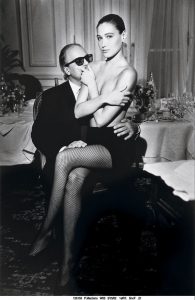Culture Jam
Fighting Blind Consumer Culture
Original Image:

This image features model Carla Bruni, and is part of over thirty years of Guess campaigns. There are obvious sexual components to this particular ad, such as the clothes (or lack thereof) that Bruni wears, and the way she is placed on the lap of a man who is visibly older than her, but they are also part of a deeper pervasive theme that runs through the entirety of Guess campaigns. In a 2012 interview with WWD, chief executive officer and creative director of Guess Paul Marciano speaks on his experiences with and choices for the brand, including the process of choosing models. In this article they are referred to as Guess Girls, and Marciano reveals that to properly represent the brand, the female models must be “young, sexy and adventurous”, as well as “healthy”, which Marciano explains as not so think that they look like a waif. On the opposite end, Marciano states that the men seen in Guess ads must be strong, so as to “counterpoint the sensuality of the women in the campaigns”. This proves that the male models are not held to such high standards of sensuality and sexiness as the female models.
Within this particular image, we can see the Guess mould quite clearly. Bruni is young-looking and sensual, and the man looks wealthy and has a sense of power as he looks at Bruni through his sunglasses and has his hands placed on her body in a cage-like fashion. Something that may not be apparent immediately, however, is the fact that Bruni does not only look young, but is sixteen years old in this photograph. Through the process of jamming this image, I hope to bring forward Bruni’s age, as well as comment on the over-sexualization of young women in Guess campaigns and other fashion campaigns as a whole.
Jammed Image:
 In this jammed image, I am bringing the consumer’s attention to the age of the model without explicitly revealing how old she actually is. I added the trademark “GUESS” text, as the original image had no obvious visual clues to the brand, as well as the phrase “How Old I Am”, which together reads “GUESS How Old I Am”. Before, we had an image that embodied the young and sexy criteria of a Guess campaign, and now, though the image itself has not changed, the age of the model (in this case, her extreme youth) is at the forefront, confusing and disrupting the intended sexiness of the ad. Instead of an image that has sex appeal and is easy to consume and move on from, by using the sentence “GUESS How Old I Am” the image is now an active part of the relationship between the ad and the consumer, and it begins a dialogue through which the consumer is able to engage more deeply with the image and its intended meaning.
In this jammed image, I am bringing the consumer’s attention to the age of the model without explicitly revealing how old she actually is. I added the trademark “GUESS” text, as the original image had no obvious visual clues to the brand, as well as the phrase “How Old I Am”, which together reads “GUESS How Old I Am”. Before, we had an image that embodied the young and sexy criteria of a Guess campaign, and now, though the image itself has not changed, the age of the model (in this case, her extreme youth) is at the forefront, confusing and disrupting the intended sexiness of the ad. Instead of an image that has sex appeal and is easy to consume and move on from, by using the sentence “GUESS How Old I Am” the image is now an active part of the relationship between the ad and the consumer, and it begins a dialogue through which the consumer is able to engage more deeply with the image and its intended meaning.
Although my jammed image obviously brings into question the age of the model, it was not the only goal I had. By asking the consumer to “GUESS How Old I Am”, I am challenging them to think critically of the image itself, as well as the process behind it. When confronted with the reality that Bruni is only sixteen, or even the possibility that she might not be as old as one might originally think, the consumer is asked to reconsider all images and ads they see, asking similar questions and engaging more deeply with the media they are interacting with.
The main intent of this jammed image is to juxtapose and call to attention the way that our capitalist consumer culture works, particularly with visually pleasing images that otherwise don’t bear much meaning. With the challenge I have proposed, it is harder for the viewer to blindly consume.